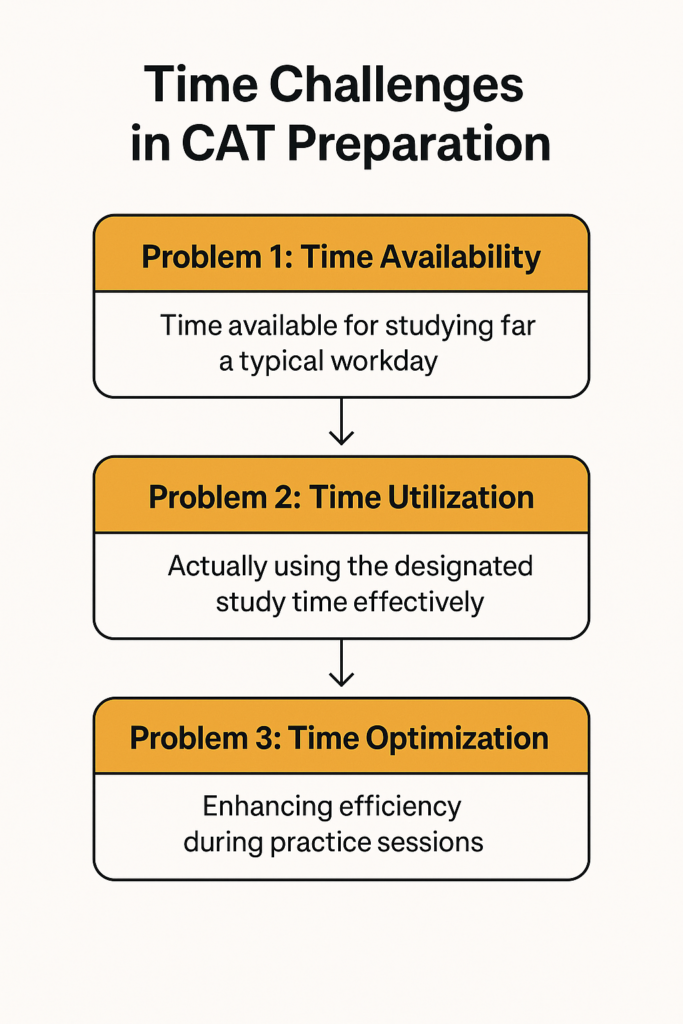
Cracking the CAT exam is no small feat, especially if you have to study in less time. Everyone tells you to study consistently for 4-5 hours a day, but no one tells you how to study more in less time especially when you’re already stretched thin with college or you have a job and you are a working professional.
If you’re wondering how to study more in less time in your day without burning out, you’re not alone. The solution isn’t just about willpower; it’s about strategy.
How to Study for CAT in Less Time
Let’s be honest; cracking CAT is hard, and it gets even harder when you’re juggling college or a full-time job. Everyone keeps saying you need to study 4–5 hours a day consistently. Sounds simple in theory, right?
But in reality, where do you even find those extra hours?
If you’re someone who’s struggling to stick to a time table, constantly feeling behind, or wondering how others manage to do it all, you’re not alone. The problem isn’t your discipline. It’s your approach.
In this blog, we’ll break down why your study plans often fail, and how to fix that, step by step, so you can study more in less time without burning out.
Understanding the Three Big Problems With Time Management When Studying for CAT
One of the main reasons your schedule doesn’t work is that you try to tackle all three problems at once, rather than easing into your timetable gradually. Let’s begin by understanding what those three problems are.

Problem 1: Time Availability for CAT Preparation
Time availability refers to the actual time you have in a day that can realistically be used for studying. Let’s understand this with an example—imagine you’re a working professional:
- You wake up at 7:00 AM, but hit the snooze button a few times and finally get out of bed by 7:30 AM.
- From 7:30 AM to 8:30 AM, you shower, get dressed, and have breakfast.
- You leave for the office around 8:30 AM.
- You work from 9:00 AM to 5:00 PM (or even later if your workload extends).
- You reach home by around 6:00 PM.
- After getting home, you scroll through social media for at least 30 minutes.
- Around 6:30 PM, you have tea and try to mentally prepare yourself to study by 7:00 PM.
- But just then, a friend might call or ask you to go out, and you decide to join them.
- You return home by 10:00 PM, have dinner, and go to bed by 11:00 PM.
The biggest challenge for many working professionals isn’t just discipline or motivation; it’s time availability itself.
The biggest challenge for many working professionals isn’t just discipline or motivation; it’s time availability itself.
Even with the best intentions, the daily routine of a working professional rarely leaves room for focused, uninterrupted study. As seen in the example, while the day technically ends around 6:00 PM, what follows is digital distractions, social obligations, and the mental exhaustion of a long day at work.
This leads us to a hard but necessary truth: Before you can be disciplined, before you can be consistent, and before you can even begin effective CAT preparation — you need to make time.
Not find it. Not hope it appears. Make it.
Time won’t just free itself up on its own. If you don’t take conscious control of your schedule and deliberately carve out fixed, protected time slots for studying, that time will be swallowed by everything else — work spillovers, social media, fatigue, or last-minute plans. You can be highly motivated, but if you’re left trying to study at the tail end of a chaotic day, your performance will suffer, and so will your confidence.
So the first step in your CAT journey isn’t solving mocks or revising quants — it’s blocking time in your day like an unmissable appointment. Guard that time fiercely. Structure your day around it. Because unless you take this step seriously, all other strategies—no matter how effective—will fall apart.
Discipline and motivation matter. But time? Time is the foundation. Without it, nothing else can stand.
Problem 2: Time Utilization
Once you have made the time available, then only you can head to the next task – the task of utilizing the time effectively. Time utilization refers to how effectively you use the time you’ve set aside for studying. In many cases, the time is available—but not actually used. Let’s continue with the same example:
- You finally sit down to study at 7:00 PM.
- You open your laptop and begin reviewing Quantitative Aptitude (QA) from your coaching material.
- Today, your study plan includes a topic test on one of the toughest areas of Arithmetic: Time, Speed & Distance.
- But then procrastination kicks in. You’re already mentally drained after a full day of work and commuting.
- The idea of diving into a difficult, mentally taxing topic feels overwhelming.
- So, instead of tackling it, you tell yourself, “I’ll do it tomorrow.”
The problem here isn’t time availability—it’s time utilization. You had the time, but you couldn’t bring yourself to use it effectively due to mental fatigue and task resistance. Once the hours are made available, your task is to plan what are the exact things that you need to do. Set specific goals as the more specific your goals are, the more likely you are to complete those goals.
Problem 3: Time Optimization
Time optimization during CAT preparation is all about increasing your practice efficiency—solving more questions in less time without compromising on accuracy or understanding. This becomes especially crucial for working professionals who have limited hours to study each day. The goal isn’t just to cover topics, but to build speed and familiarity with question types so that your practice sessions become more productive.
In VARC, this means setting a timer while solving RCs and VA questions to train your brain to process information faster. Instead of reading every word slowly, practice techniques like skimming and scanning, and build a habit of identifying the main idea quickly. For para-jumbles and summary questions, practicing in timed sets helps develop pattern recognition and intuition, reducing the time spent on each question.
In DILR, solving more sets in less time comes down to building familiarity with various puzzle types. Set mini-goals like “3 sets in 40 minutes” to push your pace. Over time, this develops both accuracy and speed in approaching new problems.
For QA, time optimization in practice involves reducing your dependency on pen and paper. Practice mental calculations, use shortcuts, and focus on mastering standard question patterns. Instead of solving 100 questions slowly, aim to solve 25-30 questions in a strict 30-45 minute session, then analyze mistakes right after. This not only builds speed but also sharpens conceptual clarity.
Ultimately, time optimization in prep is about smart repetition, time-bound practice, and reducing friction in your problem-solving process. For working professionals, it’s the most effective way to make limited study time count.
How to Fix Your Time Table to Study More
So, how do you actually make time to study for CAT when your day is already packed?
It starts with taking control of your schedule—not just hoping time will magically appear. This three-step approach helps you create time, use it better, and make every minute count. Whether you’re a student or a working professional, here’s how to study smarter, not longer.
Step 1: Fix Your Time Availability
Before you worry about how to study, make sure you actually have the time.
- Wake up earlier. If you usually wake at 7 AM, bring it down to 5 AM. This simple shift gives you a 2-hour head start.
- Don’t rush into studying right away. For the first 3 days, focus only on waking up early and freeing up time. No pressure to use it perfectly yet.
- Come home early, if possible. Try to cut down time spent lingering after work or college.
- Eliminate distractions. Social media, endless scrolling, binge-watching—cut them ruthlessly.
You can’t manage what you don’t have. Get the time first.
Step 2: Improve Your Time Utilization
Now that you have the time, use it smartly.
- Start your day with the hardest subject. For most CAT aspirants, that’s Quant (QA). Your mental energy is highest in the morning use it to tackle tough topics.
- Set SMART goals. Instead of vague goals like “study QA,” aim for something specific and measurable, like “solve 30 QA questions.”
- Break your day into two sessions. Study in the morning, then again after college or work. Even 1-2 focused hours post-work adds up.
Step 3: Optimize Your Time Like a Pro
Once you’re using your time, it’s time to get more productive.
- Solve more in fewer sittings. Build focus and stamina by gradually increasing the number of questions or chapters per sitting.
- Use micro-moments. Read an article during your commute. Revise formulas while waiting in line. 10 minutes here and there can add up to hours over a week.
Final Thoughts
Studying more in less time isn’t about pushing yourself harder—it’s about designing your day better. Fix your availability, then utilization, then optimization.
One change at a time. One habit at a time. That’s how you go from feeling stuck to being unstoppable.

Your Authors
Along with Darpan Saxena, this article has been co-authored by Om Kasarkhedkar.
Om is a marketing enthusiast with strong leadership skills, creativity and a knack for helping students with their CAT preparation. As an aspirant himself, he had received interview calls from the prestigious MDI Gurgaon and MICA, Ahmedabad.
 Get access to such unique MBA career insights
Get access to such unique MBA career insights



